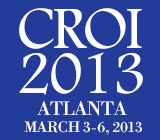 A pair of studies of the second-generation hepatitis C virus (HCV) direct-acting antiviral ABT-450, combined with ribavirin and ABT-072 or ABT-333, yielded cure rates as high as 95 percent in treatment-naive study participants, but only 47 percent in a group who had failed a previous therapy. Researchers presented findings of these two open-label studies at the 20th Conference on Retroviruses and Opportunistic Infections (CROI) in Atlanta.
A pair of studies of the second-generation hepatitis C virus (HCV) direct-acting antiviral ABT-450, combined with ribavirin and ABT-072 or ABT-333, yielded cure rates as high as 95 percent in treatment-naive study participants, but only 47 percent in a group who had failed a previous therapy. Researchers presented findings of these two open-label studies at the 20th Conference on Retroviruses and Opportunistic Infections (CROI) in Atlanta.
In one trial involving 11 treatment-naive people with genotype 1 of hep C, the most difficult to treat, the NS3/4A protease inhibitor ABT-450 by the pharmaceutical company AbbVie was combined with Norvir (ritonavir) and the NS5B polymerase inhibitor ABT-072 for 12 weeks.
The second trial had the same treatment as the first, but exchanged ABT-333 for the NS5B polymerase inhibitor ABT-072. There were three arms of this trial: two included participants never before treated for hepatitis C who received either 150 milligrams (19 people) or 250 mg (14 people) of ABT-333 each day; a third arm included 11 participants who had failed a previous hep C therapy and who took 150 mg of ABT-333.
A total of 91 percent of those in the first trial achieved a sustained virologic response (SVR, considered a cure) 24 weeks after completing treatment. Among those in the second trial, a respective 95 and 86 percent of the treatment-naive participants achieved an SVR, while only 47 percent of those who had failed a previous attempt at a cure were able to do so on this attempt.
The studies had no deaths, but one participant had an adverse event involving elevated liver enzymes without an increase in bilirubin, which led to discontinued treatment. Another four participants had severe adverse events, including high bilirubin (which can cause jaundice), fatigue, pain and vomiting, although none led them to interrupt or terminate treatment.
To read the MedPage Today story, click here.
To read the conference abstract, click here.
Advertisement
Advertisement
Advertisement






1 Comment
1 Comment